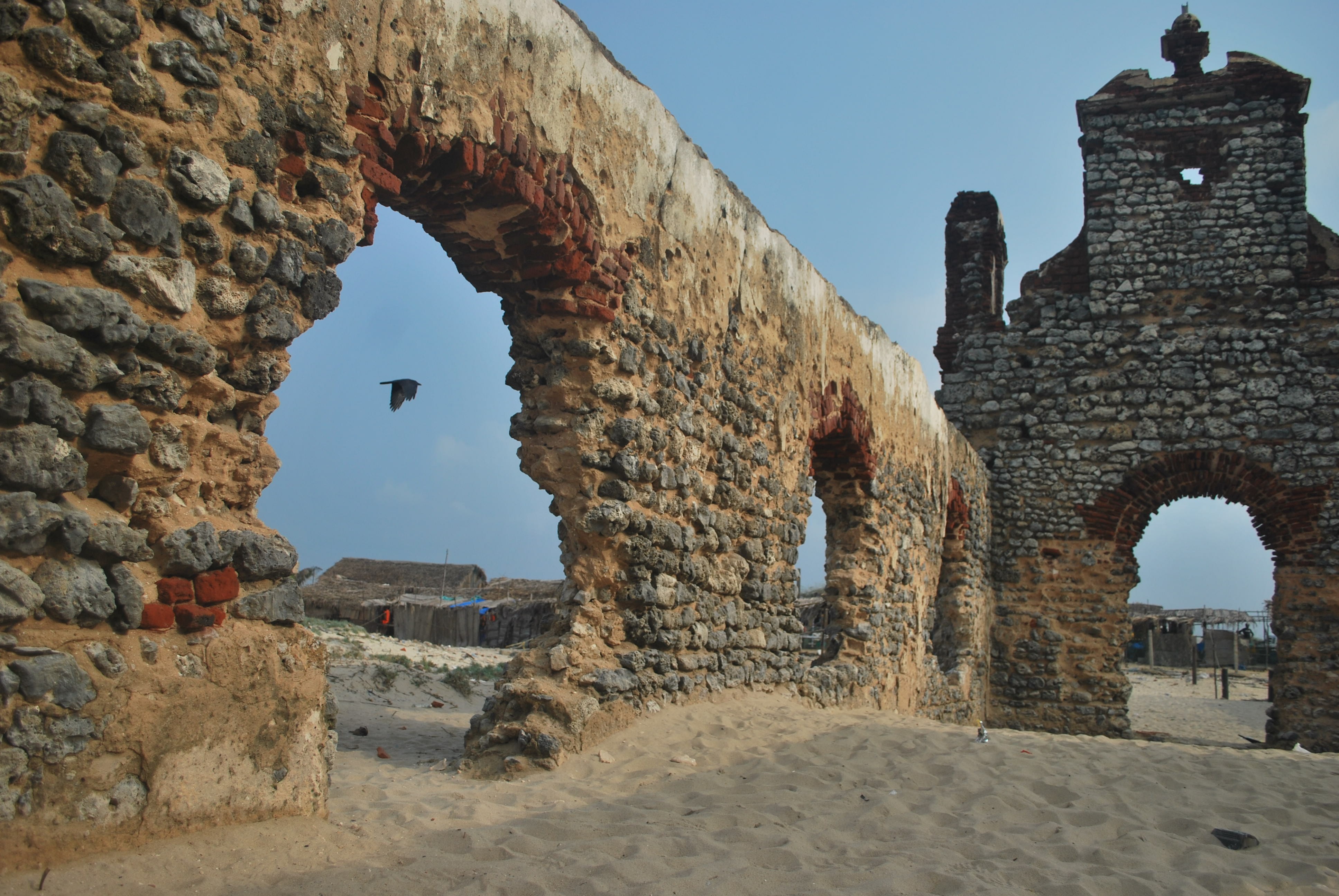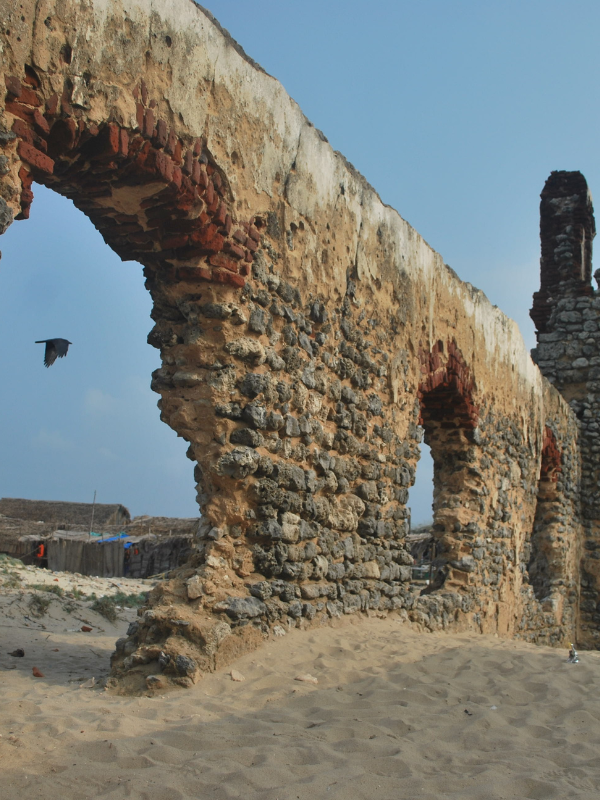

By Kalyani Majumdar
The spectral ruins of Dhanushkodi
....a reminder of
nature’s fury
As the train gently lulled its way over the Pamban
Bridge, I looked down at the sea beneath the railway tracks, gently splashing
against the rocks. It was a sunny winter’s day in December, a pleasant day, the
sea peaceful and the sky a clear blue. Travelling by train from Rameswaram to
Madurai was a cacophony of locals, their laughter and conversations sparking a
feeling of camaraderie amongst us all. Still, I couldn’t help but wonder just
how it was that fateful night on 22nd December 1964.
It was probably a journey like this one, except
that the unsuspecting travellers had no idea there were angry tidal waves as
high as 24ft waiting to hit the Pamban-Dhanushkodi passenger train, a force of
nature that would sweep it off the bridge and send it plunging into the sea,
drowning the 110 passengers, along with their stories. The deadly overnight
cyclone turned the once-bustling coastal settlement of Dhanushkodi into a ghost
town. Walking on the highway, I tried to imagine the hustle and bustle this
town must once have experienced, now buried in the sands of time as many former
structures are visible only partially.
A few years back, when
planning a backpack solo trip through southern India, I was looking for places
off the tourist map. While browsing articles online, I chanced upon a piece on
the worst cyclones to have hit India. Seeing Dhanushkodi and the Pamban Bridge
in that list, I knew I just had to retrace the steps of the last residents of
Dhanushkodi.
How to get there
You can travel to
Dhanushkodi via the road from Rameswaram. While there are state-run buses, you
can also take your own transport. It is a one-day visit, but I would still
nudge everyone to catch the train and cross the Pamban Bridge.
Why Pamban Bridge
Pamban was India’s first
sea bridge, which opened on 24th February 1914. It is a railway bridge
constructed across the Palk Strait, connecting the island town of Rameswaram to
the rest of India. What made this bridge unique was that the concrete piers had
a double-leaf bascule section (open-close mechanism) midway, which could be
raised to let ships and barges pass through. Until 1988, it was the only
surface link connecting the island of Rameswaram to mainland India.
Till 1964, this railway
line was bifurcated, with one branch line going towards Rameswaram and another
terminating at Dhanushkodi.
Dhanushkodi, a bustling
port town
There was a time when
Dhanushkodi was a busy commercial port town vibrating with life. Its proximity
to Sri Lanka—it is just 29km west of Talaimannar, in erstwhile Ceylon—made it
one of the key points of entry into India. Here, ferries would transport goods
and people to and from Sri Lanka. I could imagine passengers getting off at the
station and then heading to the other side towards the Palk Strait to board one
of the steamer ferry services between Dhanushkodi (whose pier was located on
its southeast side) and Talaimannar, which operated every day.
There were hotels, textile
shops and dharmshalas catering to travellers and pilgrims. In fact, Dhanushkodi
was an active pilgrimage site for Hindus, this being the place where, according
to the Ramayana, Lord Ram and his team of monkeys built the Ram Setu. In
those days, the town had, among other landmarks, a railway station
(Pamban-Dhanushkodi), railway hospital, Ganesh temple, higher secondary school,
post office, and customs and port offices.
So much history, on such a
small stretch
As you get off the bus, you can feel the stillness
of the place. Standing on the deserted highway, you can see on either side
ruins still fighting the elements. It is said that around 1,800 people died in
the cyclone that day, but this number could well be an underestimate. The eerie
feeling soon dissipates, however, as a bunch of schoolkids stop at a small tea
shop to buy biscuits. They were on their way to the primary school—the locals
send their kids to a one-storey building that has a painting of the late Dr.
APJ Abdul Kalam on the boundary wall, a reminder that the former president
hailed from this town. A few small restaurants are offering freshly caught
fish, fried, and served with a lemon and some onions on the side, along with
chapatti or rice, according to your preference and availability. As you descend
the road, you can see behind these eateries' traces of a railway track, the
rusted iron and wooden sleepers mostly obscured by sand. Up until 1964, one
would take the train from Pamban all the way to the point where I was standing,
next to which is a huge water tank, still upright.
On the other side of the
road, you can see the façade of the Roman Catholic church (St. Anthony’s
Church), the Ganesh temple, post office, hospital, customs office, and a
building that may once have been a school.
Reaching Palk Strait
Palk Strait is the patch of
water between the state of Tamil Nadu and Jaffna district, in the Northern
Province of Sri Lanka.
As I stood looking out over
the strait, on one side was the Indian Ocean and on the other, the Bay of
Bengal. The view from this prospect is spectacular. The vastness just hits you
differently, and you feel the impermanence of everything you understand as your
present reality. Your thoughts drift to the people of Dhanushkodi, who could
not have fathomed the fate that was about to befall them and their town, on the
morning of 22nd December 1964.
I took the bus back from
Palk Strait and got off at the ruins. It was evening. I had to say goodbye to
the fisherfolks, who shared their stories over a meal and tea, among them the
owner of a food stall named after his dad, a swimming champion in 1967 (he very
proudly showed the certificate), and the lady who may be one of the few female
Hindu priestesses you will meet. When they shared their experiences, their
stories became mine.
As I took off on the last
bus back to Rameswaram, I couldn’t help but remember the poem Ode on a
Grecian Urn by John Keats, in which the poet expresses: ‘The images on
the urn will continue to inspire and fascinate viewers long after the people
and events they depict have passed into oblivion.” In this poem lies an echo of
the destiny of Dhanushkodi.